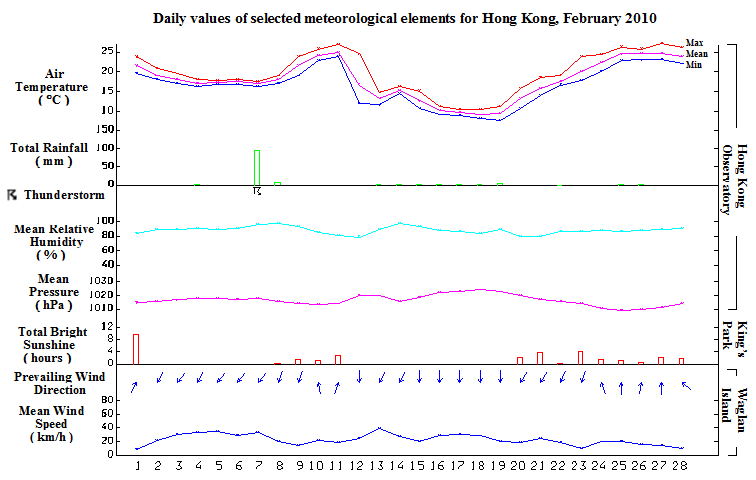|
The cold snap during the Chinese New Year period was more than counter-balanced by a persistently warm and humid maritime airstream towards the end of the month, making February 2010 wetter and milder than usual. The mean temperature for the month was 17.9 degrees, about 1.6 degrees above normal. The monthly mean relative humidity of 88 percent was about 10 percent above normal, the highest since 1959. The month was also gloomier than usual. The total bright sunshine duration of 31.8 hours was only about one-third of the normal figure of 93.8 hours, the smallest since 1985. The total rainfall in the month was 113.1 millimetres, more than double the normal figure of 52.3 millimetres.
With a warm maritime airstream prevailing over the coastal areas of Guangdong, it was foggy in Hong Kong for the first day of the month. A fresh northeast monsoon arrived at the south China coastal areas on 2 February, bringing cooler weather with fog and light rain patches to the territory. Local weather remained cloudy with mist and light rain for the ensuing four days.
Under the influence of an unstable airstream, it was overcast with periods of rain on 7 and 8 February. A total of 94.1 millimeters of rainfall was recorded at the Hong Kong Observatory on 7 February, the highest daily rainfall for February on record. Affected by a warm and humid maritime airstream, it was warm with coastal mist and fog from 9 to 11 February. The daily minimum and mean temperatures recorded at the Hong Kong Observatory on 11 February were 23.9 degrees and 25.0 degrees respectively, both the highest for February on record.
Meanwhile, a cold front had formed over central China, and moved southwards steadily over inland Guangdong. It crossed the coastal areas on the morning of 12 February. Affected by the intense northeast monsoon behind the cold front, local temperatures fell significantly from about 25 degrees at first to around 12 degrees by midnight. It remained cold and windy with a few rain patches the next day. Despite the weakening of the northeast monsoon, local weather remained cool with fog and a few rain patches on 14 February.
The northeast monsoon over south China intensified significantly on 15 February and brought cold and rainy weather to the territory for the ensuing six days. The temperatures recorded at the Hong Kong Observatory dropped to a minimum of 7.7 degrees on 19 February, the lowest of the month.
The northeast monsoon over the coastal areas of Guangdong moderated and replaced by a humid easterly airstream on 21 February. Local temperatures started to rise on that day. It was rather mild with mist from 21 to 24 February. With a maritime airstream prevailing, it was foggy with local temperature and relative humidity rising further for the last four days of the month.
|
